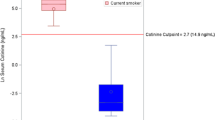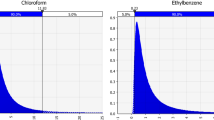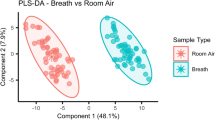Abstract
The relationships between levels of volatile organic compounds (VOCs) in blood and air have not been well characterized in the general population where exposure concentrations are generally at parts per billion levels. This study investigates relationships between the levels of nine VOCs, namely, benzene, chloroform, 1,4-dichlorobenzene, ethylbenzene, methyl tert-butyl ether (MTBE), tetrachloroethene, toluene, and m-/p- and o-xylene, in blood and air from a stratified random sample of the general US population. We used data collected from 354 participants, including 89 smokers and 265 nonsmokers, aged 20–59 years, who provided samples of blood and air in the National Health and Nutrition Examination Survey (NHANES) 1999–2000. Demographic and physiological characteristics were obtained from self-reported information; smoking status was determined from levels of serum cotinine. Multiple linear regression models were used to investigate the relationships between VOC levels in air and blood, while adjusting for effects of smoking and demographic factors. Although levels of VOCs in blood were positively correlated with the corresponding air levels, the strength of association (R2) varied from 0.02 (ethylbenzene) to 0.68 (1,4-DCB). Also the blood–air relationships of benzene, toluene, ethylbenzene, and the xylenes (BTEX) were influenced by smoking, exposure–smoking interactions, and by gender, age, and BMI, whereas those of the other VOCs were not. Interestingly, the particular exposure–smoking interaction for benzene was different from those for toluene, ethylbenzene, and the xylenes. Whereas smokers retained more benzene in their blood at increasing exposure levels, they retained less toluene, ethylbenzene, and xylenes at increasing exposure levels. Investigators should consider interaction effects of exposure levels and smoking when exploring the blood–air relationships of the BTEX compounds in the general population.
This is a preview of subscription content, access via your institution
Access options
Subscribe to this journal
Receive 6 print issues and online access
$259.00 per year
only $43.17 per issue
Buy this article
- Purchase on Springer Link
- Instant access to full article PDF
Prices may be subject to local taxes which are calculated during checkout

Similar content being viewed by others
References
Adgate J.L., Eberly L.E., Stroebel C., Pellizzari E.D., and Sexton K. Personal, indoor, and outdoor VOC exposures in a probability sample of children. J Expo Anal Environ Epidemiol 2004: 14 (Suppl 1): S4–S13.
American Society of Anesthesiologists. Aging and the Respiratory System. Available: http://www.asahq.org/clinical/geriatrics/aging.htm[accessed May 1 2007].
Backer L.C., Egeland G.M., Ashley D.L., Lawryk N.J., Weisel C.P., White M.C., Bundy T., Shortt E., and Middaugh J.P. Exposure to regular gasoline and ethanol oxyfuel during refueling in Alaska. Environ Health Perspect 1997: 105 (8): 850–855.
CDCa National Center for Health Statistics (NCHS). National Health and Nutrition Examination Survey Data. U.S. Department of Health and Human Services, Centers for Disease Control and Prevention, Hyattsville, MD, 1999–2000. Available: http://www.cdc.gov/nchs/nhanes.htm[accessed February 1 2007].
CDCb National Center for Health Statistics (NCHS). National Health and Nutrition Examination Survey, 1999-Current. Operations Manuals, Brochures, Consent Documents. U.S. Department of Health and Human Services, Centers for Disease Control and Prevention: Hyattsville, MD. Available: http://www.cdc.gov/nchs/about/major/nhanes/currentnhanes.htm[accessed February 1 2007].
CDCc National Center for Health Statistics (NCHS). National Health and Nutrition Examination Survey 1999-2000. Laboratory Procedures Manuals. U.S. Department of Health and Human Services, Centers for Disease Control and Prevention: Hyattsville, MD. Available: http://www.cdc.gov/nchs/about/major/nhanes/lab_methods99_00.htm[accessed February 1 2007].
CDCd National Center for Health Statistics (NCHS).Continuous NHANES Web Tutorial. U.S. Department of Health and Human Services, Centers for Disease Control and Prevention, Hyattsville, MD. Available: http://www.cdc.gov/NCHS/tutorials/currentnhanes[accessed June 1 2007].
Crapo R.O., and Morris A.H. Standardized single breath normal values for carbon monoxide diffusing capacity. Am Rev Respir Dis 1981: 123 (2): 185–189.
Delfino R.J., Gong H., Linn W.S., Hu Y., and Pellizzari E.D. Respiratory symptoms and peak expiratory flow in children with asthma in relation to volatile organic compounds in exhaled breath and ambient air. J Expo Anal Environ Epidemiol 2003: 13 (5): 348–363.
Duarte-Davidson R., Courage C., Rushton L., and Levy L. Benzene in the environment: an assessment of the potential risks to the health of the population. Occup Environ Med 2001: 58 (1): 2–13.
Egeghy P.P., Hauf-Cabalo L., Gibson R., and Rappaport S.M. Benzene and naphthalene in air and breath as indicators of exposure to jet fuel. Occup Environ Med 2003: 60 (12): 969–976.
Egeghy P.P., Tornero-Velez R., and Rappaport S.M. Environmental and biological monitoring of benzene during self-service automobile refueling. Environ Health Perspect 2000: 108 (12): 1195–1202.
Egorov A.I., Tereschenko A.A., Altshul L.M., Vartiainen T., Samsonov D., LaBrecque B., Maki-Paakkanen J., Drizhd N.L., and Ford T.E. Exposures to drinking water chlorination by-products in a Russian city. Int J Hyg Environ Health 2003: 206 (6): 539–551.
Elliott L., Longnecker M.P., Kissling G.E., and London S.J. Volatile organic compounds and pulmonary function in the Third National Health and Nutrition Examination Survey, 1988–1994. Environ Health Perspect 2006: 114 (8): 1210–1214.
Fustinoni S., Consonni D., Campo L., Buratti M., Colombi A., Pesatori A.C., Bonzini M., Bertazzi P.A., Foa V., Garte S., Farmer P.B., Levy L.S., Pala M., Valerio F., Fontana V., Desideri A., and Merlo D.F. Monitoring low benzene exposure: comparative evaluation of urinary biomarkers, influence of cigarette smoking, and genetic polymorphisms. Cancer Epidemiol Biomarkers Prev 2005: 14 (9): 2237–2244.
Giardino N.J., and Andelman J.B. Characterization of the emissions of trichloroethylene, chloroform, and 1,2-dibromo-3-chloropropane in a full-size, experimental shower. J Expo Anal Environ Epidemiol 1996: 6 (4): 413–423.
IARC. Monographs on the evaluation of the carcinogenic risk of chemicals to humans. Benzene. Vol. 45 International Agency for Research on Cancer, Lyon, France, 1989.
IARC. Polynuclear Aromatic Compounds Part 4, Bitumens, Coal-Tars and Derived Products, Shale-Oils and Soots. Vol. 35 International Agency for Research on Cancer, Lyon, France, 1985.
Johnson E.S., Langard S., and Lin Y.S. A critique of benzene exposure in the general population. Sci Total Environ 2007: 374 (2–3): 183–198.
Kim S., Vermeulen R., Waidyanatha S., Johnson B.A., Lan Q., Rothman N., Smith M.T., Zhang L., Li G., Shen M., Yin S., and Rappaport S.M. Using urinary biomarkers to elucidate dose-related patterns of human benzene metabolism. Carcinogenesis 2006a: 27 (4): 772–781.
Kim S., Vermeulen R., Waidyanatha S., Johnson B.A., Lan Q., Smith M.T., Zhang L., Li G., Shen M., Yin S., Rothman N., and Rappaport S.M. Modeling human metabolism of benzene following occupational and environmental exposures. Cancer Epidemiol Biomarkers Prev 2006b: 15 (11): 2246–2252.
Knox E.G. Childhood cancers and atmospheric carcinogens. J Epidemiol Community Health 2005: 59 (2): 101–105.
Kohn M.C., and Melnick R.L. Species differences in the production and clearance of 1,3-butadiene metabolites: a mechanistic model indicates predominantly physiological, not biochemical, control. Carcinogenesis 1993: 14 (4): 619–628.
Kuo H.W., Chiang T.F., Lo I.I., Lai J.S., Chan C.C., and Wang J.D. Estimates of cancer risk from chloroform exposure during showering in Taiwan. Sci Total Environ 1998: 218 (1): 1–7.
Lee S.C., Guo H., Lam S.M., and Lau S.L. Multipathway risk assessment on disinfection by-products of drinking water in Hong Kong. Environ Res 2004: 94 (1): 47–56.
Lin Y.S., Kupper L.L., and Rappaport S.M. Air samples versus biomarkers for epidemiology. Occup Environ Med 2005: 62 (11): 750–760.
Lin Y.S., Smith T.J., Kelsey K.T., and Wypij D. Human physiologic factors in respiratory uptake of 1,3-butadiene. Environ Health Perspect 2001: 109 (9): 921–926.
Lin Y.S., Vermeulen R., Tsai C., Waidyanatha S., Lan Q., Rothman N., Smith M.T., Zhang L., Shen M., Li G., Yin S., Kim S., and Rappaport S.M. Albumin adducts of electrophilic benzene metabolites in benzene-exposed and control workers. Environ Health Perspect 2007: 115 (1): 28–34.
Lindstrom A.B., Pleil J.D., and Berkoff D.C. Alveolar breath sampling and analysis to assess trihalomethane exposures during competitive swimming training. Environ Health Perspect 1997: 105 (6): 636–642.
Meek M.E., Beauchamp R., Long G., Moir D., Turner L., and Walker M. Chloroform: exposure estimation, hazard characterization, and exposure-response analysis. J Toxicol Environ Health B Crit Rev 2002: 5 (3): 283–334.
Mehlman M.A. Carcinogenicity of methyl-tertiary butyl ether in gasoline. Ann N Y Acad Sci 2002: 982: 149–159.
Mutti A. Biological monitoring in occupational and environmental toxicology. Toxicol Lett 1999: 108 (2–3): 77–89.
Pappas G.P., Herbert R.J., Henderson W., Koenig J., Stover B., and Barnhart S. The respiratory effects of volatile organic compounds. Int J Occup Environ Health 2000: 6 (1): 1–8.
Prah J., Ashley D., Blount B., Case M., Leavens T., Pleil J., and Cardinali F. Dermal, oral, and inhalation pharmacokinetics of methyl tertiary butyl ether (MTBE) in human volunteers. Toxicol Sci 2004: 77 (2): 195–205.
Rappaport S.M., and Kupper L.L. Variability of environmental exposures to volatile organic compounds. J Expo Anal Environ Epidemiol 2004: 14 (1): 92–107.
Rappaport S.M., Waidyanatha S., Qu Q., Shore R., Jin X., Cohen B., Chen L.C., Melikian A.A., Li G., Yin S., Yan H., Xu B., Mu R., Li Y., Zhang X., and Li K. Albumin adducts of benzene oxide and 1,4-benzoquinone as measures of human benzene metabolism. Cancer Res 2002: 62 (5): 1330–1337.
Rumchev K., Spickett J., Bulsara M., Phillips M., and Stick S. Association of domestic exposure to volatile organic compounds with asthma in young children. Thorax 2004: 59 (9): 746–751.
Sabbioni G., and Jones C.R. Biomonitoring of arylamines and nitroarenes. Biomarkers 2002: 7 (5): 347–421.
Sexton K., Adgate J.L., Church T.R., Ashley D.L., Needham L.L., Ramachandran G., Fredrickson A.L., and Ryan A.D. Children's exposure to volatile organic compounds as determined by longitudinal measurements in blood. Environ Health Perspect 2005: 113 (3): 342–349.
Sexton K., Adgate J.L., Ramachandran G., Pratt G.C., Mongin S.J., Stock T.H., and Morandi M.T. Comparison of personal, indoor, and outdoor exposures to hazardous air pollutants in three urban communities. Environ Sci Technol 2004: 38 (2): 423–430.
Sprung J., Gajic O., and Warner D.O. Review article: age related alterations in respiratory function -anesthetic considerations: [Article de synthese : Les modifications de fonction respiratoire liees a l’age - considerations anesthesiques]. Can J Anaesth 2006: 53 (12): 1244–1257.
Steffen C., Auclerc M.F., Auvrignon A., Baruchel A., Kebaili K., Lambilliotte A., Leverger G., Sommelet D., Vilmer E., Hemon D., and Clavel J. Acute childhood leukaemia and environmental exposure to potential sources of benzene and other hydrocarbons; a case–control study. Occup Environ Med 2004: 61 (9): 773–778.
Stern B.R., and Tardiff R.G. Risk characterization of methyl tertiary butyl ether (MTBE) in tap water. Risk Anal 1997: 17 (6): 727–743.
USEPA. An Introduction to Indoor Air Quality: Organic Gases (Volatile Organic Compounds — VOCs) 2007. Available: http://www.epa.gov/iaq/voc.html.
Vayghani S.A., and Weisel C. The MTBE air concentrations in the cabin of automobiles while fueling. J Expo Anal Environ Epidemiol 1999: 9 (3): 261–267.
Wallace L., Buckley T., Pellizzari E., and Gordon S. Breath measurements as volatile organic compound biomarkers. Environ Health Perspect 1996: 104 (Suppl 5): 861–869.
Wallace L.A. The TEAM Study: Summary and Analysis. Vol. 1. EPA 600/6-87/002a. NTIS PB 88-100060 U.S. Environmental Protection Agency, Washington, 1987a.
Wallace L.A., Pellizzari E.D., Hartwell T.D., Davis V., Michael L.C., and Whitmore R.W. The influence of personal activities on exposure to volatile organic compounds. Environ Res 1989: 50 (1): 37–55.
Wallace L.A., Pellizzari E.D., Hartwell T.D., Sparacino C., Whitmore R., Sheldon L., Zelon H., and Perritt R. The TEAM (Total Exposure Assessment Methodology) Study: personal exposures to toxic substances in air, drinking water, and breath of 400 residents of New Jersey, North Carolina, and North Dakota. Environ Res 1987b: 43 (2): 290–307.
Wei W., Kim Y., and Boudreau N. Association of smoking with serum and dietary levels of antioxidants in adults: NHANES III, 1988–1994. Am J Public Health 2001: 91 (2): 258–264.
Wolter K.M. Introduction to Variance Estimation. Springer-Verlag, New York, 1985.
Acknowledgements
This work was partly supported by the G67702 Seed Research Program from the University of North Texas Health Science Center at Fort Worth. We appreciate the suggestions of Dr. Gordon G. Brown and the staff at the National Center for Health Statistics who conducted the National Health and Nutrition Examination Survey (NHANES) and made the data available. We declare that we have no competing financial interests. The United States Environmental Protection Agency through its Office of Research and Development collaborated in the research described here. It has been subjected to Agency review and approved for publication.
Author information
Authors and Affiliations
Corresponding author
Rights and permissions
About this article
Cite this article
Lin, Y., Egeghy, P. & Rappaport, S. Relationships between levels of volatile organic compounds in air and blood from the general population. J Expo Sci Environ Epidemiol 18, 421–429 (2008). https://doi.org/10.1038/sj.jes.7500635
Received:
Accepted:
Published:
Issue Date:
DOI: https://doi.org/10.1038/sj.jes.7500635
Keywords
This article is cited by
-
Smoking is associated with elevated blood level of volatile organic compounds: a population-based analysis of NHANES 2017–2018
Archives of Public Health (2023)
-
Association of metabolites of benzene and toluene with lipid profiles in Korean adults: Korean National Environmental Health Survey (2015–2017)
BMC Public Health (2022)
-
Associations between select blood VOCs and hematological measures in NHANES 2005–2010
Journal of Exposure Science & Environmental Epidemiology (2021)
-
Determinants of environmental styrene exposure in Gulf coast residents
Journal of Exposure Science & Environmental Epidemiology (2019)
-
The hematologic effects of BTEX exposure among elderly residents in Nanjing: a cross-sectional study
Environmental Science and Pollution Research (2019)



